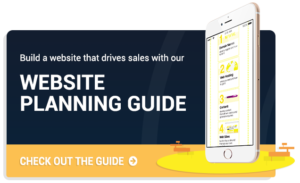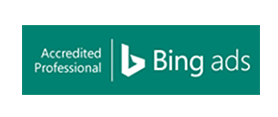When deciding what to put in your website’s footer, it is tempting to put absolutely everything that a user might want. Usually, a footer tends to be quite short on the page, so if you add in everything someone might be looking for, it may look cluttered and unhelpful.
Here are my recommended elements that you should add, so that when someone views your footer, they can see exactly what they need and don’t feel overwhelmed.
1. Contact Information
Instead of having your contact information on specific pages, adding your contact information into your footer allows the user to find ways of contacting you on the page they are on, instead of having to navigate to your contact page. The information to include should at least be your email address and business phone number. You should also consider adding your physical office address as well so that people know where you are in the world if they haven’t already worked it out.
If you have multiple locations, you may want to add the contact information for each specific location so that users can get in touch with the right branch. Although, if you have a lot of locations this could make your footer look messy, so you may just want to create a page listing the contact details for all your locations and link to that instead.
2. Links
If someone has read to the bottom of one of your pages, they may want to move onto another page. By having links in your footer, this means that they do not have to scroll all the way back to the top of your page to go on to the next page. Useful pages may include links to your homepage, about us page, contact page and any other pages someone might be interested in when they first visit your website.
If you have a lot of services, you should consider using multiple columns to display your links and order them neatly, such as your first column being links about your business i.e. about us, contact etc, and your second column could be a list of your main services. You should add a title to the top of each column so it is easy to identify what types of links are in each column and the user doesn’t waste time finding the page they want.
3. Social Profiles
Adding social profiles to your footer lets people know that you can be contacted in other ways as well, and they can also see your recent activities if you keep your social media updated. The main two profiles you should have are Twitter and Facebook, but if you have more social profiles, add them in as well, such as Instagram, LinkedIn and Google+. Most footers include social links in the form of icons, as they look clean and don’t take up too much space in your footer.
4. Copyright Symbol, Brand Name and Year
These are very small and a lot of people don’t notice them, but this tells people that your content is protected and that they aren’t allowed to copy your content and put it onto their website. Here is an example of how simple this can be:
© Bowler Hat 2017
Also, by adding the current year people will know that you take good care of your website. If you don’t want to manually change your footer every year, there are small snippets of code you can use instead which will update automatically, such as the examples on updateyourfooter.com. I’ve been on many websites that don’t update their footer and it looks bad even if they are displaying last year, it just looks like the website has been abandoned.
5. Call To Action
If you still have a lot of space left over, you could add a call to action as another way for people to get in touch or sign up to a campaign. As the CTA will likely be the largest element in your footer, it will be easy to see, so you should design your call to action with the user in mind.
Conclusion
Although these are just recommendations, it’s hard to go wrong if you put these into your footer. If you keep your footer short it should look good on responsive devices, and also it won’t make the bottom of your website look like a mess.
To gain more tips on how to improve your website or some small business SEO tips, check out the rest of our blogs!









2 Responses
Can I just put the copyright in my website ? Or are there any things I need to do ?
Hi Lynk, copyright laws do depend on the country such as some countries require the full word “copyright”, while for others just the © icon is sufficient. If you are in the UK, this guide could help you out: http://www.copyrightservice.co.uk/copyright/p03_copyright_notices
Andrew